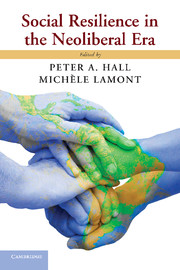Book contents
- Frontmatter
- Contents
- Contributors
- Foreword
- Prologue
- Acknowledgments
- Introduction
- Part I Neoliberalism
- Part II The Social Sources of Individual Resilience
- Part III Social Resilience on a Macro Scale
- PART IV Communities and Organizations as Sites for Social Resilience
- 9 Neoliberalism in Québec
- 10 Can Communities Succeed When States Fail Them?
- 11 Cultural Sources of Institutional Resilience
- 12 The Origins and Dynamics of Organizational Resilience
- Index
- References
10 - Can Communities Succeed When States Fail Them?
A Case Study of Early Human Development and Social Resilience in a Neoliberal Era
Published online by Cambridge University Press: 05 May 2013
- Frontmatter
- Contents
- Contributors
- Foreword
- Prologue
- Acknowledgments
- Introduction
- Part I Neoliberalism
- Part II The Social Sources of Individual Resilience
- Part III Social Resilience on a Macro Scale
- PART IV Communities and Organizations as Sites for Social Resilience
- 9 Neoliberalism in Québec
- 10 Can Communities Succeed When States Fail Them?
- 11 Cultural Sources of Institutional Resilience
- 12 The Origins and Dynamics of Organizational Resilience
- Index
- References
Summary
Early human development matters. By school age, the experiences children have had in the places where they have grown up, lived, and learned have influenced their level of development, that is, understanding and expressing language, sense of belonging, capacity for empathy and self-control, and ability to focus on complex tasks (Barker 1994; Bronfenbrenner 1979; Wadsworth 1997). Some children grow up in warm, responsive environments that protect them from inappropriate disapproval and punishment and where there are opportunities to explore their world, to play, and to learn how to speak and listen to others (Ramey and Ramey 1998). But others do not. Although abuse and neglect are serious matters, these relatively subtle differences in children's day-to-day environments accumulate into large developmental effects. For example, the number of words a child can recognize and express by age three years varies by more than threefold among otherwise normally developing children. This is because receptive and expressive language skills improve in a “dose-response” fashion with the number and variety of words spoken directly to them, and the forms in which language is used, during those three years (Hart and Risley 1995a). By the time they reach school age, the American child who has heard the most language has actually heard approximately 30 million more words than the child who has heard the least (Hart and Risley 1995b)!
Early experiences, and the state of development they produce, go on to influence health, well-being, learning, and behavior across the balance of the life course. By the second decade of life, early experiences influence the risk of school failure, teen pregnancy, and criminality. By the third and fourth decades of life, early life influences obesity, blood pressure, and depression; by the fifth and sixth decades, coronary heart disease and diabetes; and by late life, premature aging and memory loss (Harkonmäki et al. 2007) Social factors, from the most intimate experiences within the family to the most global, influence early human development in tangible and highly interdependent ways. Taken together, these factors function similar to complex adaptive ecological systems in nature.
- Type
- Chapter
- Information
- Social Resilience in the Neoliberal Era , pp. 293 - 318Publisher: Cambridge University PressPrint publication year: 2013
References
- 5
- Cited by



